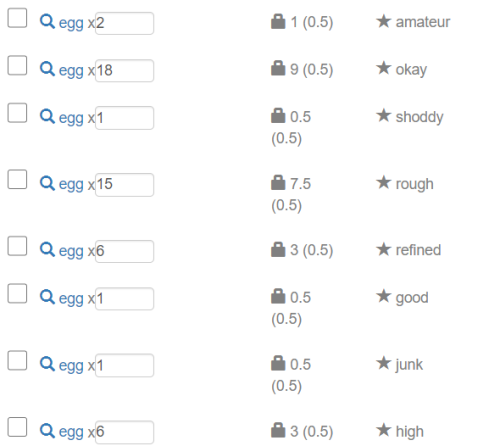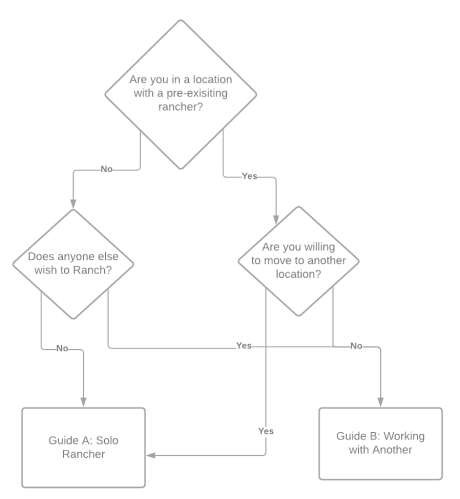This is an old revision of the document!
Guide: Ranching
MechanicalRP
This guide is classified as both mechanical and roleplay due to the way ranching works both socially and within the system.
Please note, this guide will become defunct upon the animal overhaul.
Contents
- 1 MECHANICAL
- 1.1 Can it be Tamed?
- 1.2 What Does an Animal Give?
- 1.3 Attention Meters
- 1.4 Collecting Tips and Tricks
- 1.5 Alternative Methods
- 2 ROLEPLAY
- Click Give Attention and feed the animal 10 ingredients. It is worth noting that quality has no significance here so it is a great way to get rid of ten junk meat just lying around in excess. It also takes a set 5 hours and is initiator only.
- Send it out with mail. You can do this by clicking send mail, selecting the item you wish to send and a location. Note, this can lead to the loss of an animal depending on external factors such as theft, dangerous animals on a populated tile or the target town keeping/not returning it.
- Collect from it. This can only be done with herd animals. To collect from an animal that can give milk, eggs, wool or honey, you first need to click the collect button which is found to the right of the animal name, not under it. Then you add the number of ingredients to match your herd total and ensure in the case of sheep and similar that you have selected the right product [wool or milk].
- To avoid this you can match feed with the skill level of the completing rancher. This means if you are a novice, feed the animal quality 2 food. If the person completing the project is an expert, feed it quality 4 food.
- Also, if the harvested items don’t match your skill level, either stick to one quality or more preferably, tame and butcher an animal. The meat will equal your skill level and can be used to collect eggs, milk or honey in quantities over 2 for an increased return.
- Remember, eggs are eggs, milk is milk, wool is wool and honey is honey. They are not mechanically different therefore having a cow, a goat and a sheep will give you the same output. Milk. It is more efficient to have multiples of the same animals.
- The Most Important Thing: Clicking each animal in your flock/herd does not increase all of their attention meters. It only increases the first. The system reads it as 1 x seagull egg project = 1 x attention to seagull number 1. It does not pick up which seagull you selected. To reset all 9 metaphorical seagull attention meters, you should select 9 ingredients when feeding to set up a large egg collection project equal to egg output per bird type x amount of that bird type in the flock - in this case, 9 x egg as seagulls give 1 egg per collection. Upon completion, this will reset all 9 animals.
- You are the only rancher on the tile
- You have moved somewhere to be the only rancher on tile
- You are at a location with another, pre-existing rancher
- You are the pre-existing rancher and someone else wishes to ranch
MECHANICAL
Firstly, we will look at the mechanical side of things, common misconceptions and how to tend for animals within Marosia.Can it be Tamed?
One of the first things to check when starting out is can your target animal even be tamed. Most animals are listed here. If it indicates Yes, then you can tame it if you have 10 of the same ingredients in your inventory. They must be of the same quality. They can be crafted ingredients but this is a waste of time if not for roleplay purposes. Both skill level and ingredient quality are included in your success chance.What Does an Animal Give?
If it can be tamed and you have done so, your tamed animal may now be a herd animal or a standard animal. If it is a herd animal, you can gather either eggs, milk, wool or honey from it. If not, you can butcher it for meats, hides and fur. You can find this information here.When ranching for eggs, milk, wool and honey, the outcome item quality will depend on the skill of those on the project and the feed you give it. It only takes into account whole skill levels so it doesn’t currently matter if you are a Novice at 0% or Novice at 50%.
When butchering for meats, hides and fur, the animal will drop the normal hunting quantity but at the same level of your skill. Note: Butchered goods fall to the ground rather than go into your inventory irrespective of inventory capacity.
Attention Meters
Now you have a tamed animal, you will notice an attention meter when clicking the name of any animal owned by you. This number can range from 0% to 100% and changes colour accordingly. When it reaches 0%, it will go wild at the next daily reset tick (midnight EST).To reset attention meters you can:
Collecting Tips and Tricks
We all (should) hate lists of ingredients that look like this:
Please note that the piles now round down to the nearest .5 so your variety of piles will be smaller. The above still guides you on how to minimise even that.
Alternative Methods
Other than owning animals for milk, eggs, wool and honey, butchering them or helping out with other people’s animals, you can also tan leather.Tanning leather works by having 5 hides of any quality (normally junk) either in your inventory or on the ground. You need a tanning rack in your area, meaning outside, inside a building or vehicle. You then select leather under materials in the crafting list. Leather quality will equal the quality level of the skill.
ROLEPLAY
This part of the guide goes into the challenges and rewards of the rancher lifestyle. >br>Ranching can be one of the most mechanically beneficial roles within the games, providing both ingredients that cannot be gathered and materials at various qualities up to master. It is also roleplay rich as you can work with the animals, roleplaying their personalities and interactions with others.
First thing’s first, however, if there is already a rancher at your target location, you might run into some problems and/or need to adjust your plans due to the highly restrictive 30 animal cap per tile. Follow my handy flow chart to see what guide will be best to follow.

Guide A
Guide A covers the following scenarios:This is the ideal scenario. The only things you have to consider during this scenario is mount and mail quantity. If you are in a town, you might need to limit your herd/flock to fifteen or twenty to allow to this.
Setting up:
An ideal aim [working under the 15 animal limit] is to have 5 egg-producing animals, 5 honey-producing animals and 5 animals that produce both milk and wool such as sheep or mountain goats.
You should also aim to have each of those 5 animals be exactly the same. This means 5 fuzzbees, not 3 fuzzbees and 2 luminous butterflies.
Another good tip is to replace or only tame animals which give you higher amounts. Seagulls give one egg whereas Geese give three, in this scenario choosing five geese is a more intelligent choice as you will return two eggs for every one put in. The only exception to this is cows vs sheep, while cows give more milk, sheep give a secondary benefit and therefore are the superior choice.
Day to Day:
Roleplay to your heart's content with your herd/flock and for the neatest outcome, match the input with skill. If you are an expert you want high (qual. 4) quality ingredients going in as it will give high-quality milk/eggs/wool/honey out.
Butcher animals for added flare, nicer meats, better fur and leather or simply to match ingredient with skill level.
Guide B
Guide B covers the following scenarios:This scenario is more advanced than Guide A simply because collaborative working is required. Smart working is also required as you are likely to be in a busy town nearing the 0 or negative animal space mark.
Option 1- you are the newcomer.
In this version of the scenario, you should seek out the preexisting rancher and see if you can either help out by working the majority of a project, have projects set to your skill level or take over an entire category of work - meaning they would give you all of the birds and you would be solely responsible for only the egg production in town. These ideas are expanded in the reverse within Option 2. You can also tan leather, this would work best in a location that has a natural source of hides that are high in volume and unused.
Option 2 - you are the pre-existing rancher.
In this version of the scenario, you should aim to work with the other person. Having an apprentice is always a good idea, especially as you reach higher levels and even mastery where you might not want to spend your time working on things.
There are several approaches you can take and most have been briefly outlined above.
Approach 1: if they are active or if you are active, have them work the bulk of some projects with either you kicking them off or them stepping off before the end. This works well if you are a higher skill level or a master.
Approach 2: find out their skill level and set them up 2-10 projects [your activity level vs their activity level dependant] so they don’t run out between your waking hours and put in ingredients that match their levels so your output is a maximum of two piles - yours and theirs. Then, only set up one project for yourself. This way it’s clearly stated whose is whose.
Approach 3: give the new rancher a section of animals. Meaning all the birds, or all the sheep or all the bees. Entrust them with the output of that category and you can focus on the others. This works well if your activity patterns don’t work well or if they are being stubborn about wanting their own to work with.
Approach 4: ask them to tame animals for you to butcher. This works especially well in locations without a pre-existing varied herd, a location with loads of chefs or when you have mastered and want to show off the fancy meats, hides and furs.
Authors: Poldora#0120